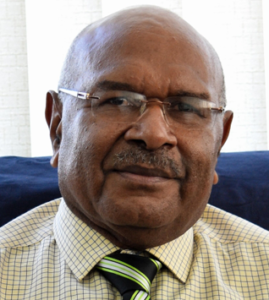There are concerns in Papua New Guinea’s mining industry that proposed changes to the Mining Act may discourage investment in the sector. The Executive Director of the PNG Chamber of Mines and Petroleum, Professor Albert Mellam, has said the mining sector is ‘strongly opposed’ to the revised Act.

The Chamber of Mines and Petroleum’s Albert Mellam. Source: LoopTV
Since 1992, Papua New Guinea’s Mining Act has provided the main regulatory framework for the mining sector. While a revision of the Act has been mooted for several years, the industry is expressing concerns at current proposed revisions.
Speaking in Brisbane recently at a business event, the PNG Chamber of Mines’ Executive Director Albert Mellam pointed to several ‘issues’ with the proposed revision.
One is that the maximum term of a mining lease be reduced from 40 years to 25 years and the renewal period for a mining licence be reduced from a maximum of 20 years to 10 years.
He questioned proposals that the state be given the right to compulsorily acquire the mine upon expiry of the first term of the mining lease. He described this as ‘expropriation’.
Mellam further queried proposals to limit the state’s exposure to sunk costs (expenses that cannot be recovered).
‘There are also no grandfathering provisions (phasing in of the new laws),’ he said.
‘Existing mines would be required to comply within 12 months, and any changes to government policy take precedence over the mining development contract (MDC).’
Fly in, fly out
Mellam also targeted proposals to regulate fly-in-fly-out (FIFO) activities undertaken by mining companies.
‘The powers of authorising officers are excessive and in some cases open to abuse.
‘The definition of “offshore” will lead to confusion with existing projects.’
‘Penalties are excessive and punitive. For example, a person engaging in FIFO—which is not defined—could be locked up for 15 years.’
He added that failing to provide information to the authorities could lead to a jail term of two years.
‘The definition of “offshore” will lead to confusion with existing projects that are onshore/offshore,’ he added.
Mellam did find some positives with the proposed revisions, however, pointing to the extension of exploration leases from two years to five years.
Also beneficial would be improvements to documentation, with plans required for community engagement, employment and training and rehabilitation. Feasibility studies and waste management methods would also be required.
‘The PNG authorities face a choice.’
Mellam was also critical of a proposal in the MRA Act to increase the production levy from 0.25 per cent to 0.5 per cent of gross production.
He pointed to the removal of any ‘direct or indirect representation’ for the industry on the Mineral Resource Authority’s (MRA’s) board.
Choice
Craig Jones, Executive General Manager for the proposed Wafi-Golpu gold-copper mine in Morobe Province, also speaking in Brisbane, said the PNG authorities must embrace one of two choices in revising the legislation.
‘The first is to ensure the continuation of stable fiscal and regulatory policies which have underwritten past successes of the resources sector in Papua New Guinea.
‘There is a great deal of uncertainty and nervousness created by the proposed amendments.’
‘(The second is) to grasp at legislative and taxation changes that will shake investor confidence and repel further investment in PNG.
‘But there is a great deal of uncertainty and nervousness created by the proposed amendments to the new Mining Act—the changes recently made to the MRA and changes to the taxation regime introduced in the 2017 Budget.’
Gas
Mellam was more positive on proposed natural gas policy, arguing for an investment framework that ‘properly supports a third party access regime for gas pipelines and related infrastructure’.
He regarded in a favourable light the requirement to meet domestic market obligations by providing up to 15 per cent of production for local use.
The requirement to use locally sourced labour he likewise considered to be a positive.
But he remained concerned about the future of the Mining Act, which he described as ‘critical to future investments in mineral exploration and development.’








Speak Your Mind